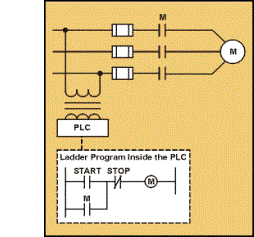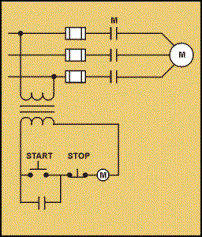|
 Project
Describtion Project
Describtion  Parallel
Operation Parallel
Operation  Switching
Devices Switching
Devices  PLC PLC
 Matlab Matlab
مواقع
مفضله بحث
بحث  سجل الزوار
سجل الزوار  شكر وعرفان
شكر وعرفان  من
أنا من
أنا

 PLC
history PLC
history
 PLCs
were introduced in the late 1960s to take on the role previously played by
sequential relays in machine control. Relays are placed onto a single panel to
provide a special control circuit referred to as logic or relay logic. The
purpose of a logic circuit is to allow an event, such as the starting of a
motor, to occur only if predetermined conditions are met. PLCs
were introduced in the late 1960s to take on the role previously played by
sequential relays in machine control. Relays are placed onto a single panel to
provide a special control circuit referred to as logic or relay logic. The
purpose of a logic circuit is to allow an event, such as the starting of a
motor, to occur only if predetermined conditions are met.
Although
relay circuits performed their job well, they could be very expensive to install
and maintain. In fact, the primary reason for designing PLCs was eliminating the
large cost of replacing complicated relay-based machine control systems. Picture
a machine control panel that included hundreds or thousands of individual
relays. The size could be mind boggling. How about the complicated initial
wiring of so many individual devices? These relays would be individually wired
together to yield the desired outcome. As you can imagine, such a complicated
system brought with it many problems.
When
production requirements changed, the control system had to be updated. If
frequent changes were required, system updates became very expensive. Because
relays are mechanical devices, they also have a limited lifetime, requiring
strict adhesion to maintenance schedules. Troubleshooting was also time
consuming with so many relays involved.
To
be a cost- and time-efficient replacement for relays, PLCs needed to be easy for
maintenance and plant engineers to program, their lifetime had to be long, and
they had to survive the harsh industrial environment. That's a lot to ask! The
answers lay in using a programming technique-Relay Ladder Logic-based on the
relay technology people were already familiar with, and replacing mechanical
parts with solid-state ones.
Figure
3. Traditional Relay Logic&PLC logic.
In
the early 1970s, the dominant PLC technologies were sequencer-state machines and
the Bit-slice based Central Processing Unit (CPU). Initially, conventional
microprocessors lacked the power to solve PLC logic quickly in all but the
smallest PLCs. However, as conventional microprocessors evolved, larger and
larger PLCs were based upon them.


Communications
abilities began to appear around 1973. The PLC could now talk to other PLCs and
could be far away from the machine it was controlling. Because PLCs could also
now be used to send and receive varying voltages, they were able to enter the
Analog world. But despite these advances, lack of standardization coupled with
continually changing technology still made PLC communications a nightmare of
incompatible protocols and physical networks. The 1980s, however, saw an attempt
to standardize communications. PLCs also got smaller in size and became software
programmable through symbolic programming on personal computers (previously,
PLCs had required dedicated programming terminals or handheld programmers).
Today, the world's smallest PLC is about the size of a single control relay!
The
1990s have seen a gradual reduction in the introduction of new protocols, and
the modernization of the physical layers of some of the more popular protocols
that survived the 1980s. The latest standard (IEC 1131-3) has tried to merge PLC
programming languages under one international standard. We now have PLCs that
are programmable in function block diagrams, instruction lists, C, and
structured text all at the same time. Personal Computers (PCs) are also being
used to replace PLCs in some applications. What will the future bring? Only time
will tell.
HOME
PLC MENU
|